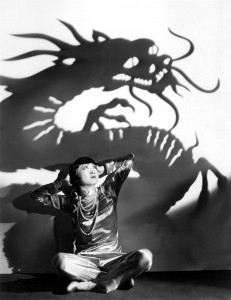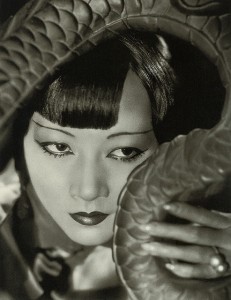
The Daughter of the Dragon, 1931

Photograph of Anna May Wong, Otto Dyar 1932
The exhibit “China through the looking Glass” allows viewers to to visualize and understand Chinese fashion imagination through film and art. The “Enigmatic Body” is a particularly fascinating concept that leads us to many questions about Chinese symbolism, culture, and fashion. In the image, The Daughter of the Dragon (1931), Anna May Wong sits in the shadow of a Chinese dragon. In the image on the right, by Otto Dyar, Wong hides behind the body of the dragon. In both images, we see Wong pictured with the Chinese dragon in a black and white or discolored representation.
The decision to insert Anna May Wong as the focal point of each photo:
to centralize or to frame?
Anna May Wong, the first Chinese American movie star and first Asian American actress to gain international recognition. The artists of both images choose to insert a very beautiful, well known, talented film start to be the focal point in their image. This immediately causes the audience to question this decision and ask why they made this choice. As discussed in class, the dragon represents power and strength and the insertion of this beautiful talented woman in addition to the dragon, connotes her power and strength as a “dragon lady.”
In an image earlier in the exhibit, we see Wong pictured on a stage with a Western audience who’s eyes are fixed on her body. Hollywood portrays Asian women as “dragon ladies” through the image of Wong in her performance. The images above present this portrayal once again through the decision to insert a highly valued, beautiful Asian film star as the focal point of an image that includes the dragon.
make an effort to support the claim of “enigmatic bodies”
The dragon:
The dragon has been a symbol throughout Chinese history that holds significant meaning in Chinese culture. It represents power, excellence, strength, and heroism. We have seen the dragon appear in certain aspects of Chinese life, however, through the study of Enigmatic Bodies in particular, we are able to understand its significance in Chinese culture as it is paired with an attractive and famous Asian female. The dragon was included in each piece featured in the exhibit in order to make a statement of power and strength.
how does the symbol of dragon signify the concept of “enigmatic bodies?”
The artists’ choice of color:
The Enigmatic Bodies images foster an alluring and intriguing experience for the viewer. Mystery, concealment, and attraction are present in each of the images above. The image named “The Daughter and the Dragon,” is in black and white. The image by Dyar is also a colorless image. I think this choice and technique is very effective in the representation of the themes of mystery, concealment, and attraction because it adds a significant amount of secrecy to the images. In the image on the right, it looks as if Wong is peering out from behind the dragon skin. The image holds a lot of secrecy and concealment, yet also highlights her power and strength as a “dragon lady.” In the image on the left, Wong sits in front of the dragon’s shadow. We are able to see more of her body, however, we are still left with mysteriousness. It is interesting to wonder how these images would be different if they were in color. How would color change them and change their connotations, symbolisms, and meaning?
good organization. explain persuasively how the two images conceptualize “enigmatic bodies.”
